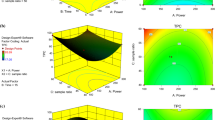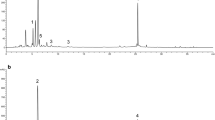Abstract
In this study, for the first time, polyphenols are extracted using microwave-assisted deep eutectic solvents (MW-DES) from supercritical CO2 defatted date seeds under variable operating conditions. The best conditions consisted of choline chloride: formic acid (1:2 molar ratio), a solid to solvent ratio of 1/20 (g/mL) (0.75 g of dry biomass in 15 mL solvent), an extraction time of 50 s, and a microwave power of 400 W. The maximum polyphenols extraction yield was 128 g gallic acid equivalent/kg dry biomass (g GAE/kg) (which is the highest value ever reported in literature for date seeds extracts). The antioxidant activity of the optimum extracts was assessed with the DPPH and ABTS quenching capacities being equal to 27 and 145 mg trolox equivalent/g dry biomass, respectively. Mainly mannose and manno-oligosaccharides were solubilized during extraction. The highest yields were (obtained at 200 W, 120 s) 35.07 and 32.18 mg/g of dry biomass for mannose and manno-oligosaccharides, respectively. It was also observed that the total mannose (monomer and oligomer) release during the extraction increased linearly (r2 = 0.9951) with respect to microwave energy applied per gram of date seeds (J/g).







Similar content being viewed by others
References
Ferreira CFRI, Martins N, Barros L (2017) Chapter One - Phenolic compounds and its bioavailability: in vitro bioactive compounds or health promoters?, Editor(s): Fidel Toldrá, Advances in Food and Nutrition Research, Academic Press 82:1–44
Ruesgas-Ramon M, Figueroa-Espinoza MC, Durand E (2017) Application of deep eutectic solvents (DES) for phenolic compounds extraction: overview, challenges, and opportunities. J Agric Food Chem 65:3591–3601
Pal CBT, Jadeja GC (2019) Microwave-assisted deep eutectic solvent extraction of phenolic antioxidants from onion (Allium cepa L.) peel: a Box-Behnken design approach for optimization. J Food Sci Technol 56:4211–4223
Lu W, Liu S (2020) Choline chloride–based deep eutectic solvents (Ch-DESs) as promising green solvents for phenolic compounds extraction from bioresources: state-of-the-art, prospects, and challenges. Biomass Conv Bioref. https://doi.org/10.1007/s13399-020-00753-7
Hellwig V, Gasser J (2020) Polyphenols from waste streams of food industry: valorisation of blanch water from marzipan production. Phytochem Rev 19:1539–1546
Chao CCT, Krueger RR (2007) The date palm (Phoenix dactylifera L.) overview of biology uses, and cultivation. J Am Soc Hortic 42:1077–1082
Alharbi KL, Raman J, Shin HJ (2021) Date fruit and seed in nutricosmetics. Cosmetics 8:59
Al-Farsi MA, Lee CY (2008) Nutritional and functional properties of dates: a review. Crit Rev Food Sci Nutr 48:877–887
Tang ZX, Shi LE, Aleid SM (2013) Date fruit: chemical composition, nutritional and medicinal values, products. J Sci Food Agric 93:2351–2361
Hong YJ, Tomas-Barberan FA, Kader AA, Mitchell AE (2006) The flavonoid glycosides and procyanidin composition of Deglet Noor dates (Phoenix dactylifera). J Agric Food Chem 54:2405–2411
Li B, Akram M, Al-Zuhair S, Elnajjar E, Munir MT (2020) Subcritical water extraction of phenolics, antioxidants and dietary fibres from waste date pits. J Environ Chem Eng 8(6):104490
Maqsood S, Kittiphattanabawon P, Benjakul S, Sumpavapol P, Abushelaibi A (2015) Antioxidant activity of date (Phoenix dactylifera var. Khalas) seed and its preventive effect on lipid oxidation in model systems. Int Food Res J 22(3):1180–1188
Al-Farsi M, Alasalvar C, Al-Abid M, Al-Shoaily K, Al-Amry M, Al-Rawahy F (2007) Compositional and functional characteristics of dates, syrups, and their by-products. Food Chem 104(3):943–947
Afifi HS, Hashim IB, Altubji SI (2017) Optimizing extraction conditions of crude fiber, phenolic compounds, flavonoids and antioxidant activity of date seed powder. J Food Sci Technol 54:4149–4161
Kuppusamy S, Venkateswarlu K, Megharaj M (2020) Examining the polyphenol content, antioxidant activity and fatty acid composition of twenty-one different wastes of fruits, vegetables, oilseeds and beverages. SN Appl Sci 2:673
Ivanovic M, Islamčević Razboršek M, Kolar M (2020) Innovative extraction techniques using deep eutectic solvents and analytical methods for the isolation and characterization of natural bioactive compounds from plant material. Plants 9(11):1428
Abbott AP, Capper G, Davies DL, Rasheed RK, Tambyrajah V (2003) Novel solvent properties of choline chlorida/urea mixtures. Chem Commun 1:70–71
Isci A, Kaltschmitt M (2021) Recovery and recycling of deep eutectic solvents in biomass conversions: a review. Biomass Convers Biorefin. https://doi.org/10.1007/s13399-021-01860-9
Food Drug Administration (FDA) (2017) GRAS Notices, GRN No. 668 Sodium formate, https://www.fda.gov/media/101304/download. Accessed 13 Jul 2022
Pandey A, Bhawna DD, Pandey S (2017) Hydrogen bond donor/acceptor cosolvent-modified choline chloride-based deep eutectic solvents. J Phys Chem B 121(16):4202–4212
Chanioti S, Tzia C (2018) Extraction of phenolic compounds from olive pomace by using natural deep eutectic solvents and innovative extraction techniques. Innov Food Sci Emerg Technol 48:228–239
Chemat F, Cravotto G (2012) Microwave-assisted extraction for bioactive compounds: theory and practice. Springer, New York
López-Linares JC, Campillo V, Coca M, Lucas S, García-Cubero MT (2021) Microwave-assisted deep eutectic solvent extraction of phenolic compounds from brewer’s spent grain. J Chem Technol Biotechnol 96:481–490
Gao MZ, Cui Q, Wang LT, Meng Y, Yu L, Li YY, Fu YJ (2020) A green and integrated strategy for enhanced phenolic compounds extraction from mulberry (Morus alba L.) leaves by deep eutectic solvent. Microchemical Journal 154:104598
Bonacci S, Di Gioia ML, Costanzo P, Maiuolo L, Tallarico S, Nardi M (2020) Natural deep eutectic solvent as extraction media for the main phenolic compounds from olive oil processing wastes. Antioxidants 9:513
Kehili M, Kammlott M, Choura S, Zammel A, Zetzl C, Smirnova I, Allouche N, Sayadi S (2017) Supercritical CO2 extraction and antioxidant activity of lycopene and β-carotene-enriched oleoresin from tomato (Lycopersicum esculentum L.) peels by-product of a Tunisian industry. Food Bioprod Process 102:340–349
Isci A, Thieme N, Lamp A, Zverlov V, Kaltschmitt M (2021) Production of xylo-oligosaccharides from wheat straw using microwave assisted deep eutectic solvent pretreatment. Ind Crops Prod 164:113393
Slinkard L, Singleton VL (1977) Total phenol analysis: automation and comparison with manual methods. Am J Enol Vitic 28:49–55
Nie J, Chen D, Lu Y (2020) Deep eutectic solvents based ultrasonic extraction of polysaccharides from edible brown seaweed Sargassum horneri. J Mar Sci Eng 8(6):440
Santos-Sánchez NF, Salas-Coronado R, Villanueva-Cañongo C, Hernández-Carlos B (2019) Antioxidant compounds and their antioxidant mechanism. In Antioxidants; Shalaby, E., Ed.; IntechOpen: London, UK
Müller L, Fröhlich K, Böhm V (2011) Comparative antioxidant activities of carotenoids measured by ferric reducing antioxidant power (FRAP), ABTS bleaching assay (α-TEAC), DPPH assay and peroxyl radical scavenging assay. Food Chem 129:139–148
Kehili M, Choura S, Zammel A, Allouche N, Sayadi S (2017) Oxidative stability of refined olive and sunflower oils supplemented with lycopene-rich oleoresin from tomato peels industrial by-product, during accelerated shelf-life storage. Food Chem 246:295–304
Javanmardi J, Kubota C (2006) Variation of lycopene, antioxidant activity, total soluble solids and weight loss of tomato during postharvest storage. Postharvest Biol Technol 41:151–155
Sluiter A, Hames B, Ruiz R, Scarlata C, Sluiter J, Templeton D (2006) Determination of sugars, byproducts, and degradation products in liquid fraction process samples. National Renewable Energy Laboratory (NREL) Laboratory Analytical Procedures, NREL/TP-510–42623.
Wu M, Liao K, Liu C et al (2021) Integrated and sustainable preparation of functional nanocellulose via formic acid/choline chloride solvents pretreatment. Cellulose 28:9689–9703
Aissaoui T, Benguerba Y, AlOmar MK, AlNashef IM (2017) Computational investigation of the microstructural characteristics and physical properties of glycerol-based deep eutectic solvents. J Mol Model 23:277
Muley PD, Mobley JK, Tong X, Novak B, Stevens J, Moldovan D, Shi J, Boldor D (2019) Rapid microwave-assisted biomass delignification and lignin depolymerization in deep eutectic sol-vents. Energ Conversion Manag 196:1080–1088
Bubalo MC, Ćurko N, Tomašević M, Ganić KK, Redovniković IR (2016) Green extraction of grape skin phenolics by using deep eutectic solvents. Food Chem 200:159–166
Chen J, Liu M, Wang Q, Du H, Zhang L (2016) Deep eutectic solvent-based microwave-assisted method for extraction of hydrophilic and hydrophobic components from Radix Salviae miltiorrhizae. Molecules 21(10):1383
Dai Y, Witkamp GJ, Verpoorte R, Choi YH (2015) Tailoring properties of natural deep eutectic solvents with water to facilitate their applications. Food Chem 187:14–19
Fraige K, Arrua RD, Sutton AT, Funari CS, Cavalheiro AJ, Hilder EF, Bolzani VDS (2019) Using natural deep eutectic solvents for the extraction of metabolites in Byrsonima intermedia leaves. J Sep Sci 42:591–597
Habib HM, Ibrahim WH (2011) Effect of date seeds on oxidative damage and antioxidant status in vivo. J Sci Food Agric 91(9):1674–1679
Metoui M, Essid A, Bouzoumita A, Ferchichi A (2019) Chemical composition, antioxidant and antibacterial activity of Tunisian date palm seed. Pol J Environ Stud 28(1):267–274
Bouaziz MA, Amara WB, Attia H, Blecker C, Besbes S (2010) Effect of the addition of defatted date seeds on wheat dough performance and bread quality. J Texture Stud 41(4):511–531
Ghnimi S, Umer S, Karim A, Kamal-Eldin A (2017) Date fruit (Phoenix dactylifera L.): an underutilized food seeking industrial valorization. NFS Journal 6:1–10
Ishrud O, Zahid M, Ahmad VU, Pan Y (2001) Isolation and structure analysis of a glucomannan from the seeds of Libyan dates. J Agric Food Chem 49(8):3772–3774
Isci A, Erdem GM, Bagder Elmaci S, Sakiyan O, Lamp A, Kaltschmitt M (2020) Effect of microwave-assisted deep eutectic solvent pretreatment on lignocellulosic structure and bioconversion of wheat straw. Cellulose 27:8949–8962
Hu X, Shi Y, Zhang P, Miao M, Zhang T, Jiang B (2016) d-Mannose: properties, production, and applications: an overview. Compr Rev Food Sci Food Saf 15(4):773–785
Wu H, Zhang W, Mu W (2019) Recent studies on the biological production of D-mannose. Appl Microbiol Biotechnol 103:8753–8761
Funding
This study was financially supported by the Alexander von Humboldt Foundation via Georg Forster Post-doctoral Researcher (Mouna Kehili) and Georg Forster Experienced Researcher (Asli Isci) Fellowships.
Author information
Authors and Affiliations
Corresponding authors
Ethics declarations
Conflict of interest
The authors declare no competing interests.
Additional information
Publisher's note
Springer Nature remains neutral with regard to jurisdictional claims in published maps and institutional affiliations.
Mouna Kehili and Asli Isci contributed equally to this work and share the first authorship.
Supplementary Information
Below is the link to the electronic supplementary material.
Rights and permissions
About this article
Cite this article
Kehili, M., Isci, A., Thieme, N. et al. Microwave-assisted deep eutectic solvent extraction of phenolics from defatted date seeds and its effect on solubilization of carbohydrates. Biomass Conv. Bioref. 14, 7695–7706 (2024). https://doi.org/10.1007/s13399-022-03027-6
Received:
Revised:
Accepted:
Published:
Issue Date:
DOI: https://doi.org/10.1007/s13399-022-03027-6




